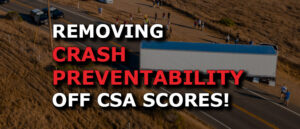How Fleets Can Easily Remove Crash Preventability Off CSA Scores
CNS can help with our Roadside & Incident Report Management service where a team of DOT Compliance Specialists will assess the Department of Transportation safety records
We are a team of DOT Compliance and Licensing Professionals helping trucking and transportation companies remain safe, compliant, and profitable.
CNS or Compliance Navigation Specialists is DOT Compliance company that assists trucking and transportation companies remain DOT Compliant. We are part of a network of companies, CNS Companies, specializing in services related to the transportation, manufacturing, construction, service, education and medical industries.

A full-scale DOT Compliance Program managing a long haul carrier’s safety, compliance, licensing and more.
Learn more >>>
A DOT Compliance Program that keeps motor carriers compliant with the 6 Basic DOT Regulations required of all carriers.
Learn more >>>
Our Short-Haul/Construction Program is a full-scale program designed for private carriers that do not haul for-hire.
Learn more >>>
Our most comprehensive DOT Compliance Program, operating as your company’s off-site Safety Director or assisting your current safety personnel.
Learn more >>>
Our Non-CDL Program is a full-scale program managing safety, compliance, licensing and more for moving companies, couriers, landscapers, or any company subject to DOT regulations and does not employ CDL drivers.
Learn more >>>
Our DOT Audit Services cover a number of different types of DOT Audits that new and existing carriers will be subject to.
Our DOT Driver Services help trucking companies and carriers to stay compliant as they grow and hire more drivers.
Our DOT Vehicle Services focus on ensuring your vehicles are compliant with DOT Regulations, which is just as important as your drivers.
Our DOT Services for Special Carriers focus on companies outside of the typical motor carrier, like HAZMAT, Passenger and Bus Carriers.
CNS is part of a group of companies that offer other necessary services for the trucking and transportation industry, such as Commercial Trucking Insurance, CDL Training, Online Training Course, and even Healthcare.
Our DOT Licensing Services will cover you whether you are an existing company or just starting a trucking company. Our DOT Licensing Specialists can help you get up and running and in days with your DOT number, MC Authority, EIN, UCR, IFTA, 2290 HVUT, Fuel Taxes and can even set you up to get your Commercial Driver's License (CDL) with CNS Driver Training Center.
Our DOT Licensing Specialists will help you with every aspect of starting a trucking company. All you need to do is choose a name for your trucking company.
You will need to ensure your DOT Number, MC Authority, Vehicle Registration, etc. is all set up properly when you start your trucking business.
Our Licensing Specialists can help with all aspects of filing and renewing licenses, fuel taxes, etc.
CNS is part of a group of companies that offer other necessary services for the trucking and transportation industry, such as Commercial Trucking Insurance, CDL Training, Online Training Course, and even Healthcare.
CNS can help with our Roadside & Incident Report Management service where a team of DOT Compliance Specialists will assess the Department of Transportation safety records
CNS or Compliance Navigation Specialists is DOT Compliance company that assists trucking and transportation companies remain DOT Compliant. We are part of a network of companies, CNS Companies, specializing in services related to the transportation, manufacturing, construction, service, education and medical industries.
CNS Companies is a network of companies specializing in services related to the transportation, manufacturing, construction, service, education and medical industries. Our DOT Compliance division is handled by Compliance Navigation Specialists, CNS Insurance handles Commercial Truck Insurance, CDL training is managed by the CNS Driver Training Center and healthcare is managed by CNS Occupational Medicine.
We are a team of DOT Compliance and Licensing Professionals helping trucking and transportation companies remain safe, compliant, and profitable.
CNS or Compliance Navigation Specialists is DOT Compliance company that assists trucking and transportation companies remain DOT Compliant. We are part of a network of companies, CNS Companies, specializing in services related to the transportation, manufacturing, construction, service, education and medical industries.

A full-scale DOT Compliance Program managing a long haul carrier’s safety, compliance, licensing and more.
Learn more >>>
A DOT Compliance Program that keeps motor carriers compliant with the 6 Basic DOT Regulations required of all carriers.
Learn more >>>
Our Short-Haul/Construction Program is a full-scale program designed for private carriers that do not haul for-hire.
Learn more >>>
Our most comprehensive DOT Compliance Program, operating as your company’s off-site Safety Director or assisting your current safety personnel.
Learn more >>>
Our Non-CDL Program is a full-scale program managing safety, compliance, licensing and more for moving companies, couriers, landscapers, or any company subject to DOT regulations and does not employ CDL drivers.
Learn more >>>
Our DOT Audit Services cover a number of different types of DOT Audits that new and existing carriers will be subject to.
Our DOT Driver Services help trucking companies and carriers to stay compliant as they grow and hire more drivers.
Our DOT Vehicle Services focus on ensuring your vehicles are compliant with DOT Regulations, which is just as important as your drivers.
Our DOT Services for Special Carriers focus on companies outside of the typical motor carrier, like HAZMAT, Passenger and Bus Carriers.
CNS is part of a group of companies that offer other necessary services for the trucking and transportation industry, such as Commercial Trucking Insurance, CDL Training, Online Training Course, and even Healthcare.
Our DOT Licensing Services will cover you whether you are an existing company or just starting a trucking company. Our DOT Licensing Specialists can help you get up and running and in days with your DOT number, MC Authority, EIN, UCR, IFTA, 2290 HVUT, Fuel Taxes and can even set you up to get your Commercial Driver's License (CDL) with CNS Driver Training Center.
Our DOT Licensing Specialists will help you with every aspect of starting a trucking company. All you need to do is choose a name for your trucking company.
You will need to ensure your DOT Number, MC Authority, Vehicle Registration, etc. is all set up properly when you start your trucking business.
Our Licensing Specialists can help with all aspects of filing and renewing licenses, fuel taxes, etc.
CNS is part of a group of companies that offer other necessary services for the trucking and transportation industry, such as Commercial Trucking Insurance, CDL Training, Online Training Course, and even Healthcare.
CNS can help with our Roadside & Incident Report Management service where a team of DOT Compliance Specialists will assess the Department of Transportation safety records
CNS or Compliance Navigation Specialists is DOT Compliance company that assists trucking and transportation companies remain DOT Compliant. We are part of a network of companies, CNS Companies, specializing in services related to the transportation, manufacturing, construction, service, education and medical industries.
CNS Companies is a network of companies specializing in services related to the transportation, manufacturing, construction, service, education and medical industries. Our DOT Compliance division is handled by Compliance Navigation Specialists, CNS Insurance handles Commercial Truck Insurance, CDL training is managed by the CNS Driver Training Center and healthcare is managed by CNS Occupational Medicine.

Any time a driver is placed out-of-service at roadside, it increases the chances of a company audit.
While a safety audit can occur at any time, there are many red flags that trigger the FMCSA to review a company’s operation.
Part of being prepared for a compliance review is knowing what can trigger an audit and how to prevent them from happening.
We will cover five common triggers that could prompt a DOT audit, which include:
The FMCSA created the Compliance, Safety, Accountability (CSA) program as a method of identifying high-risk commercial motor carriers, as well as the Safety Measurement System (SMS) which uses data from state-reported crashes, roadside inspections, and investigation results from the last two years.
Poor CSA scores will increase your chance of an audit because there are certain “Intervention Thresholds” the FMCSA uses to prioritize interventions.
Interventions are based on the number of percentiles a carrier has at or above the established BASIC Intervention Thresholds.
Being at or above these threshold limits will likely trigger a comprehensive compliance review:
| BASIC Intervention Thresholds | General | Hazmat | Passenger | |
| Unsafe Driving, Crash Indicator, HOS Compliance | 65% | 60% | 50% | |
| Maintenance, Controlled Substances, Driver Fitness | 80% | 75% | 65% | |
| HM Compliance | 80% | 80% | 80% |
While a single crash could trigger an audit, the severity of the accident will increase your chances and possibly trigger a compliance review without any prior notice.
When it comes to the Unsafe Driving/Crash BASIC indicator, too many violations could trigger an audit.
To reduce the chance of violations in this area, carriers should:
Any time a driver is placed out-of-service at roadside, the chances of a company audit increase.
To prevent drivers from being pulled in for a roadside inspection, carriers should focus on keeping the ISS score and out-of-service ratings as low as possible, especially below the national average.
While inspections do happen at random, there are common things that roadside inspectors look for when determining what drivers will be pulled in for inspection.
For example, if you have a headlight out, inspectors may assume the driver did not do a good pre-trip inspection and there could be other maintenance violations they will want to check in more detail.
Additionally, if your truck is dirty, inspectors may assume the driver is not taking care of bigger problems, like brakes or suspension.
While investigators understand that the new entrant audit is a learning curve for many new carriers, the FMCSA will monitor those who did not pass their first audit.
This is where having a firm grasp on the regulations is critical.
A lack of basic safety management controls or failure to comply with any one of the following 16 regulations will result in a notice to revoke your USDOT new entrant registration unless immediate action is taken:
Finally, anyone who finds out that a motor carrier or truck driver is engaging in negligent behavior can file a complaint with the FMCSA within 90 days from the time they learned about the behavior.
To file an FMCSA complaint, they can either call the agency at 888-DOT-SAFT or fill out an online complaint form.
Once the complaint is submitted, it becomes part of the trucking company’s permanent record in the National Consumer Complaint Database and will eventually prompt the FMCSA to investigate, especially if there are multiple recent or serious complaints.
Accuracy, organization, and diligence are crucial to keeping your files in order and ready for an audit at a moment’s notice and ensuring new drivers are properly qualified before operating in a safety sensitive position.
At CNS, our DQ file management system is completely customizable to your company’s needs. The consultants at CNS stay in communication with you regarding document updating, as well as offering comprehensive reports upon request, and reports of routine audits by our own DQ file auditors.
Our DOT Compliance Specialists will ensure all DQ files for your company will be ready to pass an FMCSA audit.
Beyond DQ files, our safety management programs are perfect for combining multiple services and focuses on Proactive Safety Management (PSM), a mindset that will ensure your fleet’s safety and compliance is always in order and ahead of the FMCSA.
Our PSM Motor Carrier Program includes:

CNS can help with our Roadside & Incident Report Management service where a team of DOT Compliance Specialists will assess the Department of Transportation safety records

Do you travel in or through British Columbia, Canada? There is now a speed limiter requirement affecting most heavy trucks, as of Friday April 5,

If your lights aren’t on at night, but they work, that’s no longer an OOS violation, though it’s still a violation of state laws to

California’s AB5 legal battles, that cover an estimated 70,000 owner-operators, lose another chance to block the rule. The AB5 law makes it more difficult for
Our DOT Compliance Programs ensure it is your top priority and keeps your business running.
Receive the latest transportation and trucking industry information about FMCSA and DOT Audits, Regulations, etc.

CNS can help with our Roadside & Incident Report Management service where a team of DOT Compliance Specialists will assess the Department of Transportation safety records

Do you travel in or through British Columbia, Canada? There is now a speed limiter requirement affecting most heavy trucks, as of Friday April 5,

If your lights aren’t on at night, but they work, that’s no longer an OOS violation, though it’s still a violation of state laws to
Join our monthly newsletter and stay up-to-date on trucking industry news and receive important compliance and licensing tips.
Join our monthly newsletter and stay up-to-date on trucking industry news and receive important compliance and licensing tips.